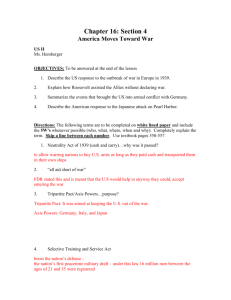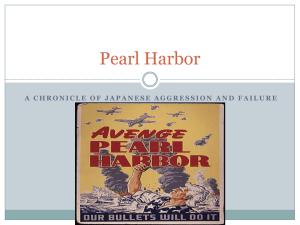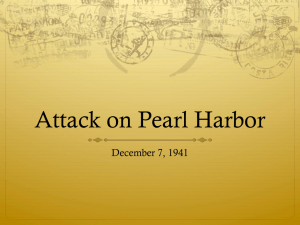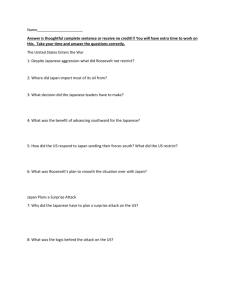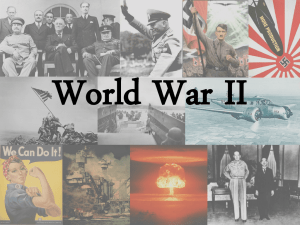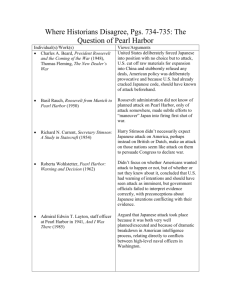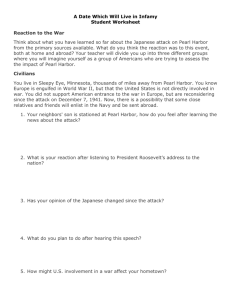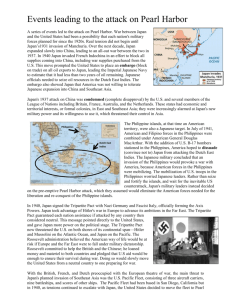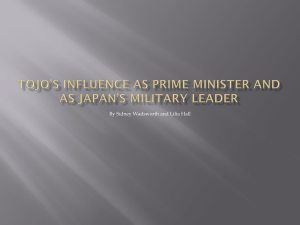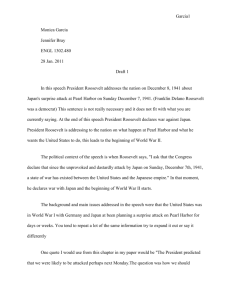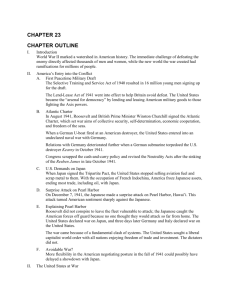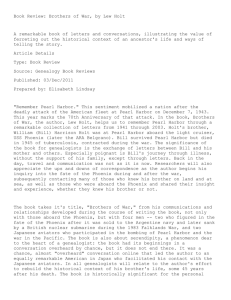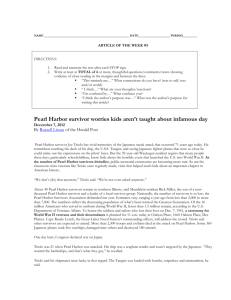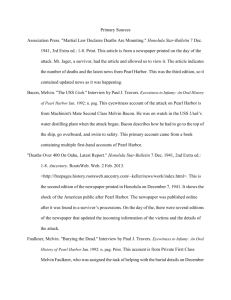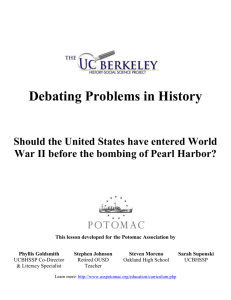Quote (optional) (Black) Transition (green)
advertisement
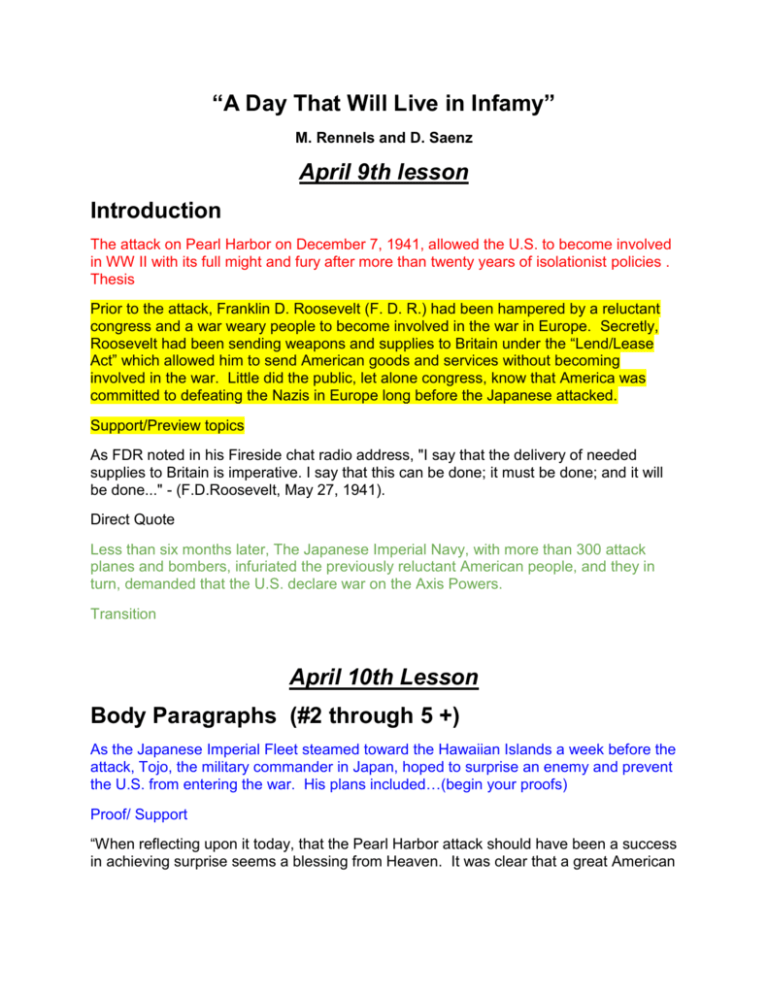
“A Day That Will Live in Infamy” M. Rennels and D. Saenz April 9th lesson Introduction The attack on Pearl Harbor on December 7, 1941, allowed the U.S. to become involved in WW II with its full might and fury after more than twenty years of isolationist policies . Thesis Prior to the attack, Franklin D. Roosevelt (F. D. R.) had been hampered by a reluctant congress and a war weary people to become involved in the war in Europe. Secretly, Roosevelt had been sending weapons and supplies to Britain under the “Lend/Lease Act” which allowed him to send American goods and services without becoming involved in the war. Little did the public, let alone congress, know that America was committed to defeating the Nazis in Europe long before the Japanese attacked. Support/Preview topics As FDR noted in his Fireside chat radio address, "I say that the delivery of needed supplies to Britain is imperative. I say that this can be done; it must be done; and it will be done..." - (F.D.Roosevelt, May 27, 1941). Direct Quote Less than six months later, The Japanese Imperial Navy, with more than 300 attack planes and bombers, infuriated the previously reluctant American people, and they in turn, demanded that the U.S. declare war on the Axis Powers. Transition April 10th Lesson Body Paragraphs (#2 through 5 +) As the Japanese Imperial Fleet steamed toward the Hawaiian Islands a week before the attack, Tojo, the military commander in Japan, hoped to surprise an enemy and prevent the U.S. from entering the war. His plans included…(begin your proofs) Proof/ Support “When reflecting upon it today, that the Pearl Harbor attack should have been a success in achieving surprise seems a blessing from Heaven. It was clear that a great American fleet had been concentrated in Pearl Harbor, and we supposed that the state of alert would be very high,” (Hideki Tojo). Direct Quote in essay (Minimum of 3) Tojo’s plan was designed on five points for success over the American Navy… Transition Body - Proof/Support (Blue) Quote (optional) (Black) Transition (green) Conclusion Paragraph After the attack on Pearl Harbor, Naval Marshal General Isoroku Yamamoto, worried, (thesis restated) "I fear all we have done is to awaken a sleeping giant and fill him with a terrible resolve,” (December 7, 1941). (Direct Quote) As the Japanese feared, America, with its rich resources and mighty resolve, turned the defeat in the Hawaiian Islands into a battle cry across the Pacific and waged a terrible war of attrition against the Japanese forces. (Summary) If Pearl Harbor was the catalyst which got America involved in the war, Hiroshima and Nagasaki was the retribution for the sneak attack on Pearl Harbor. (Point to ponder) Intro - Thesis - red Preview/support - Yellow Quote (optional) Black Transition (green) Body - Proof/Support (Blue) Quote (optional) (Black) Transition (green) Conclusion - Thesis (restated in Red) Quote (optional) Black Summary Point to Ponder The attack on Pearl Harbor on December 7, 1941, allowed the U.S. to become involved in WW II with its full might and fury after more than twenty years of isolationist policies. Prior to the attack, Franklin D. Roosevelt (F. D. R.) had been hampered by a reluctant congress and a war weary people to become involved in the war in Europe. Secretly, Roosevelt had been sending weapons and supplies to Britain under the “Lend/Lease Act” which allowed him to send American goods and services without becoming involved in the war. Little did the public, let alone congress, know that America was committed to defeating the Nazis in Europe long before the Japanese attacked. As FDR noted in his Fireside chat radio address, "I say that the delivery of needed supplies to Britain is imperative. I say that this can be done; it must be done; and it will be done..." - (F.D.Roosevelt, May 27, 1941). Less than six months later, The Japanese Imperial Navy, with more than 300 attack planes and bombers, infuriated the previously reluctant American people, and they in turn, demanded that the U.S. declare war on the Axis Powers. As the Japanese Imperial Fleet steamed toward the Hawaiian Islands a week before the attack, Tojo, the military commander in Japan, hoped to surprise an enemy and prevent the U.S. from entering the war. His plans included…“When reflecting upon it today, that the Pearl Harbor attack should have been a success in achieving surprise seems a blessing from Heaven. It was clear that a great American fleet had been concentrated in Pearl Harbor, and we supposed that the state of alert would be very high,” (Hideki Tojo). Tojo’s plan was designed on five points for success over the American Navy…
